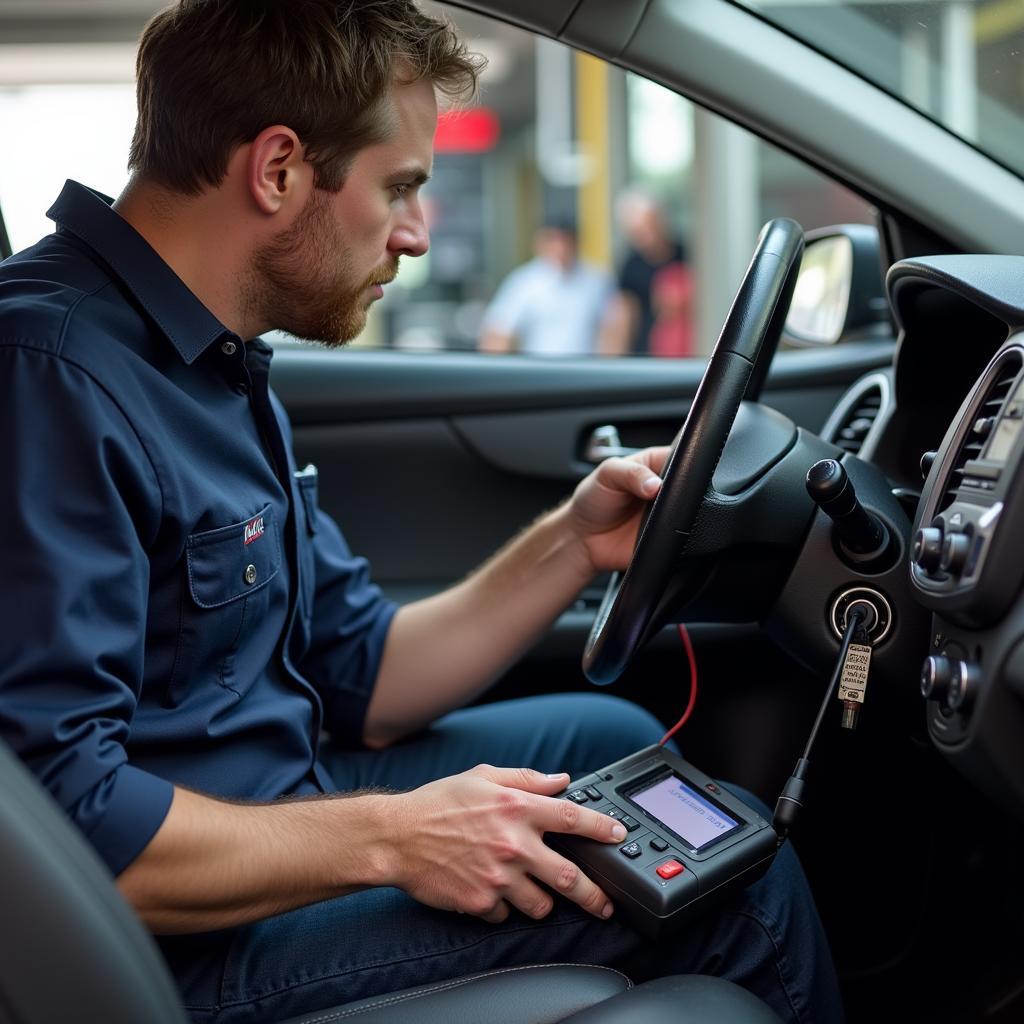Your 2010 Mini Cooper S is a zippy little car that’s fun to drive. But when that brake warning light illuminates on your dashboard, it’s a clear signal to stop and figure out what’s wrong. Ignoring this warning light can lead to serious safety hazards, so addressing it promptly is crucial. This article will guide you through the common causes of a brake warning light on a 2010 Mini Cooper S and provide insights into how remote diagnostics can help pinpoint the issue.
There are several reasons why your brake warning light might be on. Some are simple fixes, while others require professional attention. Let’s take a closer look.
Common Causes of a Brake Warning Light
1. Low Brake Fluid
One of the most frequent culprits behind a lit brake warning light is low brake fluid. Brake fluid is the lifeblood of your car’s braking system. Over time, brake pads wear down, and the fluid level naturally decreases.
How to check:
- Locate the brake fluid reservoir under the hood. It’s usually a translucent plastic container with a cap marked “Brake Fluid.”
- Check the fluid level against the minimum and maximum markers on the reservoir.
- If the fluid is below the minimum, add the recommended brake fluid for your Mini Cooper S.
Important: If you need to add brake fluid frequently, it could indicate a leak in your braking system, which requires immediate attention from a mechanic.
2. Worn Brake Pads
Your Mini Cooper S is designed to alert you when your brake pads are wearing thin. This is essential for safe braking.
How to tell if your brake pads are worn:
- Squealing or screeching noises when braking: This is the most obvious sign. The noise is caused by a wear indicator, a small metal tab built into the brake pad, contacting the rotor.
- Vibration when braking: Worn brake pads can cause uneven contact with the rotor, leading to a pulsing sensation in the brake pedal.
- Grinding noise when braking: If you ignore the squealing and vibration, you might eventually hear a grinding metal-on-metal sound. This means your brake pads are completely worn down, and the metal backing plate is scraping against the rotor, causing damage and requiring costly repairs.
3. Faulty Brake Pad Sensor
Modern cars like your Mini Cooper S have brake pad wear sensors. These sensors are small electrical wires embedded in the brake pads. When the pad wears down to a certain point, the sensor makes contact with the brake rotor, completing a circuit and triggering the brake warning light on your dashboard.
Troubleshooting a faulty sensor:
- A visual inspection of the brake pad sensors can reveal if they’re damaged, disconnected, or worn out.
- A mechanic can use a multimeter to test the sensor’s electrical continuity.
4. ABS Issue
Your Mini Cooper S is equipped with an Anti-lock Braking System (ABS). If there’s a problem with the ABS module, wheel speed sensors, or related wiring, it can trigger the brake warning light. Unlike low brake fluid or worn pads, an ABS issue usually triggers an additional warning light specifically for the ABS.
Diagnosing an ABS issue:
- Diagnosing ABS problems often requires specialized diagnostic tools.
- A qualified mechanic can read the ABS fault codes stored in your car’s computer to pinpoint the problem.
How Remote Diagnostics Can Help
Remote diagnostics can be incredibly valuable when trying to understand why your brake warning light is on. Here’s how:
- Read Fault Codes: Remote diagnostics can read the diagnostic trouble codes (DTCs) stored in your Mini Cooper S’s computer, providing valuable insights into the root cause of the warning light.
- Real-Time Data: Remote diagnostics can access live data from your car’s sensors, including brake fluid level, brake pedal position, and wheel speed sensor data. This information can help determine if a sensor is faulty or if there’s an issue with a specific component within the braking system.
- Expert Analysis: By analyzing the fault codes and live data, remote diagnostic technicians can often offer preliminary diagnoses and recommend the most appropriate course of action.
“Remote diagnostics can save Mini Cooper S owners time and money by quickly identifying the cause of a brake warning light. In many cases, we can prevent unnecessary trips to the mechanic.” – John Smith, Senior Automotive Diagnostic Technician.
Conclusion
A glowing brake warning light on your 2010 Mini Cooper S should never be ignored. By understanding the common causes and utilizing resources like remote diagnostics, you can address the issue promptly and ensure your safety on the road. Remember, regular maintenance and timely repairs are essential for keeping your Mini Cooper S in optimal condition and preventing potentially dangerous brake system failures.

